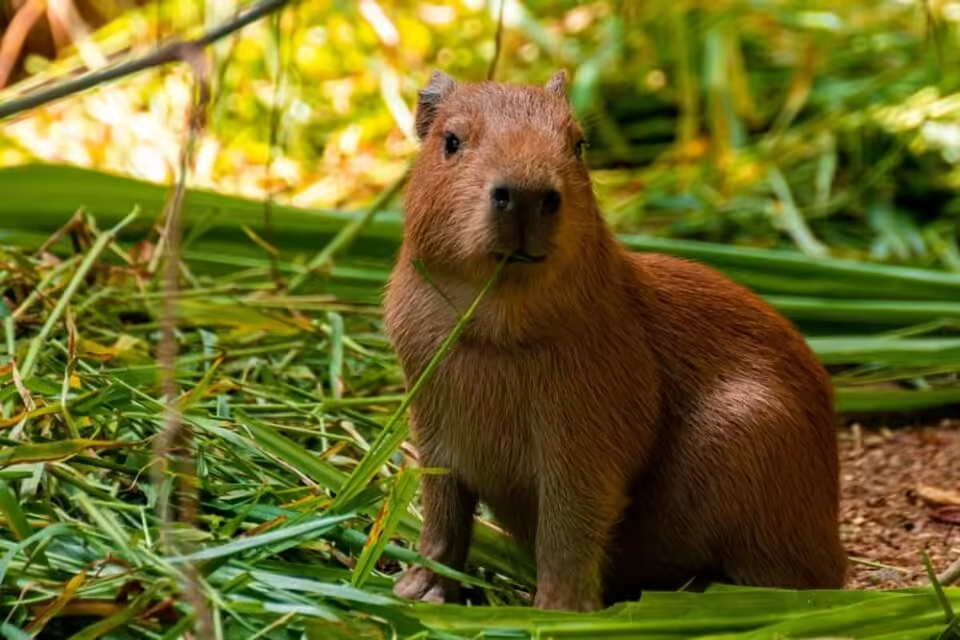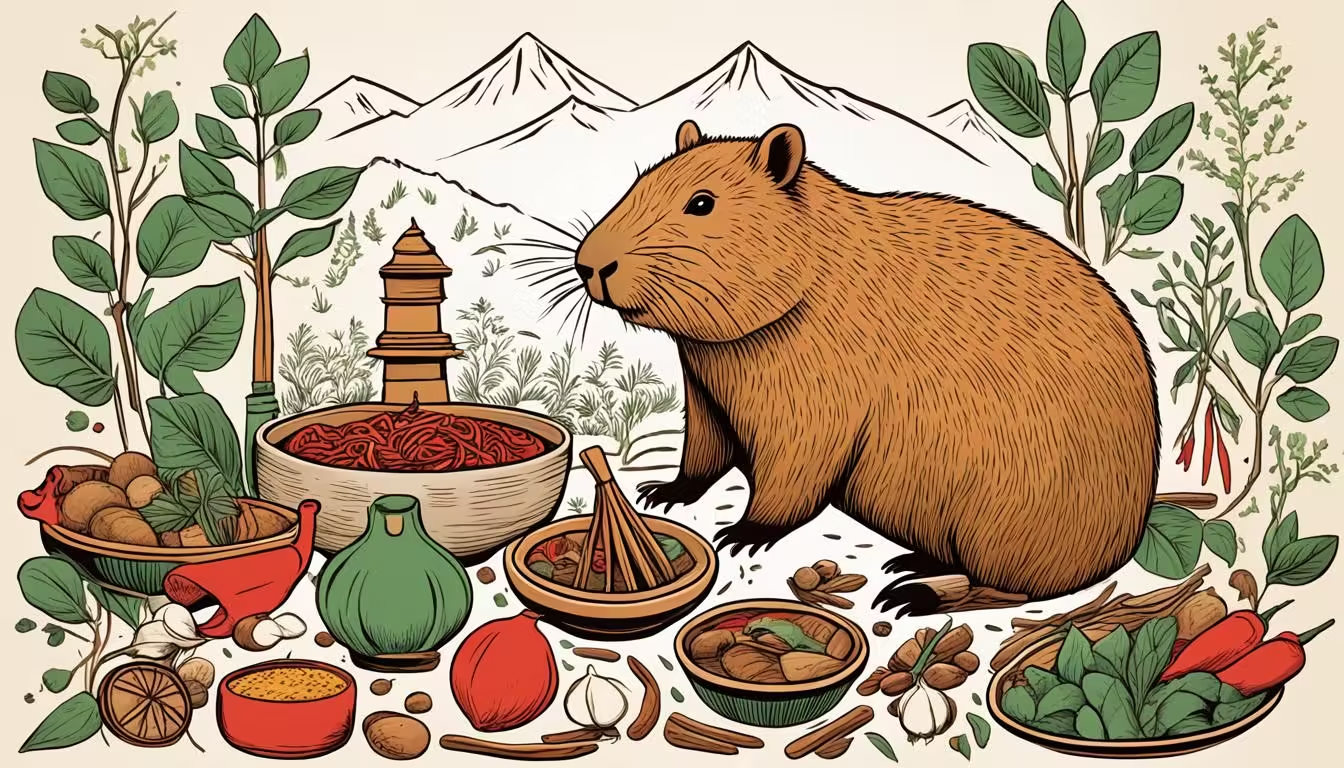These semi-aquatic animals are a food source for some people. But, deciding to eat capybara meat requires thinking about its nutrition, cooking uses, and the effects on society and the environment. This article will look into the good and bad sides of eating capybara. It aims to help you decide if it’s a good choice.
Key Takeaways
- Capybaras are the largest rodents in the world, weighing up to 170 pounds.
- Capybara meat has a unique nutritional profile that may offer health benefits.
- Consuming capybara meat can have social and environmental implications that need to be considered.
- Ethical concerns surrounding the treatment of capybaras must be addressed.
- Alternatives to eating capybara, such as plant-based proteins, may be worth exploring.
What is a Capybara?
Physical Characteristics and Habitat
Capybaras are the biggest rodents alive, growing up to 134 cm (4.4 feet) long and weighing 35 to 66 kg (77 to 146 lbs). They have a round body, short legs, a big head, small ears, and webbed feet for swimming. Their fur is reddish-brown.
These animals live in Central and South America. They like places like rainforests, grasslands, and swamps, as long as there’s water nearby. They often live in groups of 10-20, sometimes up to 50 or 100 during the dry season.
Capybaras eat mostly grasses, plants, fruits, and tree bark. They can hold their breath underwater for up to five minutes and are great swimmers. They have a 130-150 day pregnancy and have about four pups.
Even though they’re big, capybaras have many predators like big cats and caimans. They usually don’t live more than four years in the wild because of these dangers.
Legalities and Ethical Concerns of Owning a Capybara
Owning a capybara as a pet is complex and controversial. These large rodents are exotic pets in many places. Laws about owning them vary a lot by location. Some places let you have them with the right papers, but others don’t allow it at all.
One big ethical worry is the care capybaras need. They are very social and live in big groups in the wild. Keeping one alone can be bad for it, as they need friends. They also need a big area outside with a pool for swimming, since they love the water.
| Capybara Ownership Regulations | Permitted States | Prohibited Regions |
|---|---|---|
| Capybara ownership laws vary greatly by location | Texas, Pennsylvania, New York | New York City (all five boroughs) |
Looking after a capybara is hard. They need a special diet of grass hay and certain pellets with vitamin C to stay healthy. It’s a big job to take care of one, which is why experts warn against it for new exotic pet owners.
Thinking carefully about the welfare of the capybara and your ability to care for it is key. The debate on capybara ownership is ongoing. It’s important for those thinking of getting one to really understand the commitment involved.
Is it Good to Eat Capybara?
Nutritional Value and Culinary Uses
Capybara meat is a special treat in some South American areas. It’s packed with protein and has little fat, making it a good choice for health. But, it can be tough and taste gamy, which might not be for everyone. Still, people enjoy it in dishes like stews and grilled foods.
Deciding if capybara is good to eat involves looking at its health benefits and how it tastes. The meat is high in protein but can be hard to chew and has a strong taste. Whether or not to eat capybara is up to you. Think about its nutritional value and culinary uses before making a choice.
| Nutrient | Capybara Meat | Beef |
|---|---|---|
| Protein | 27g per 100g | 26g per 100g |
| Fat | 3g per 100g | 10g per 100g |
| Iron | 2.5mg per 100g | 2.3mg per 100g |
| Vitamin B12 | 1.5μg per 100g | 2.4μg per 100g |
Capybara meat’s nutrition is similar to beef, but its culinary uses are unique. It’s often used in South American dishes, adding a strong flavor with spices and other ingredients. But, its tough texture means it needs special cooking to make it tender and tasty.
“Capybara meat is a unique and flavorful protein source, but it’s important to consider both the nutritional benefits and the practical aspects of preparing and consuming this large rodent.”
Social and Environmental Impact of Capybara Consumption
Eating capybara meat has big social and environmental effects. These animals are key to their South American homes. They feed predators and help keep wetlands healthy.
If we hunt capybaras too much, it could harm the ecosystem. This could hurt many other animals too. Also, capybaras are important to some indigenous groups. Their meat trade could threaten their traditions and way of life.
“Capybaras are more than just a food source; they are a symbol of our cultural identity and a vital part of the natural balance in our region. Losing them would be a devastating blow to our way of life.”
We need to think about the big picture when it comes to capybara. Responsible and sustainable practices are key. They help protect these amazing animals and their homes.
- Capybaras keep the balance in wetland habitats in South America.
- Too much hunting could harm the ecosystem and other animals.
- The meat trade could threaten capybara’s importance to indigenous communities.
- We must eat capybara responsibly to protect them and their homes.
Ethical Considerations of Eating Capybara
Eating capybara meat brings up complex ethical questions. These smart, social animals have deep emotional and behavioral needs. Captivity can be hard to meet these needs, making us question how we treat them for food.
Thinking about the impact on the environment is key. Capybaras are important in their ecosystems. Taking them out can harm the balance of nature. We also need to think about how it affects indigenous cultures that have always seen capybaras as special.
The ethics of eating capybara also consider their unique nature. They live in groups and love the water. They need to graze, swim, and be with others. Captivity might not give them what they need, which could hurt their well-being.
Deciding to eat capybara as a food source means thinking deeply about the right thing to do. We need to be responsible, use resources wisely, and respect the capybara’s value. This should guide our choices about eating these animals.
“The true measure of a society is how it treats its most vulnerable members.”
This quote is very relevant to the debate on eating capybaras. They are smart and social, so we should treat them with great care. We must think carefully about using them as food.
Alternatives to Eating Capybara
There are many other meats you can eat instead of capybara. You could try beef, pork, and poultry. Or, you could look into game meats that don’t have the same social and environmental needs.
For those wanting to eat less animal-based food, plant-based protein sources are a good choice. These include things like legumes, grains, and meat alternatives. These options are both ethical and sustainable.
Here are some other meats that can be similar to capybara in taste:
- Agoutis, large rodents from Central and South America, can weigh up to 13 pounds and are eaten by some people.
- Pacas, which are nocturnal and live underground, can weigh up to 30 pounds. Their meat is very white, mild, and tasty, and is a delicacy in the Yucatan region.
Starting a market for these meats can be hard, though. It might need changes in culture and more investment in infrastructure. But, looking into these options can help us make more sustainable and ethical food choices.
“Capybara meat is considered superior as it is tasty, tender, and odorless, making it a popular expensive delicacy in Peru.”
The search for alternatives to capybara meat is crucial as we face the challenges of our food choices. Finding new protein sources is an important part of making better choices for the planet and animals.
Capybara Farming and Sustainability
Farming capybaras, the biggest rodents, could be a way to meet the growing need for a unique protein source sustainably. But, making capybara farming work well is hard. It faces big challenges.
Challenges and Potential Solutions
Capybaras are big, live in water, and need a lot of space and friends. They are hard to keep in farms. It’s important to keep them healthy and safe, but it’s expensive and hard.
To fix this, we need new farming ways and strict rules. Giving them food like grasses and plants they like can keep them healthy. They need lots of room, water, and friends to live well.
Also, we should use the land well and fix damaged habitats. This helps keep capybara numbers in check and protects nature. It also lowers the chance of them getting hit by cars or giving diseases to people.
By tackling the challenges of capybara farming and finding green solutions, we can make it a better choice for getting this special protein.
| Challenges of Capybara Farming | Potential Solutions |
|---|---|
| Complex social and environmental needs | Specialized feeding programs, adequate space and water access, and social structures |
| Ensuring health and welfare of captive animals | Implementing innovative farming practices and strong regulations |
| Managing environmental impact | Sustainable land-use practices and habitat restoration |
By solving these problems and using green solutions, capybara farming could become a better choice for getting this special protein.
Cultural and Traditional Perspectives
Capybara Consumption in South American Cultures
In some South American cultures, eating capybara meat is a long-standing tradition. These large rodents are very important to indigenous communities. They are seen as a valuable food and a key part of the ecosystem.
Hunting and preparing capybara meat is linked to big cultural events. In Brazil, it’s a special dish during Christmas and New Year’s. In Venezuela, it’s a big part of many celebrations, and its meat is a key ingredient in traditional meals.
But, the rise of capybara meat sales and the pressure on their homes are worrying. These changes threaten the traditional ways and the cultural value of the capybara. As cities grow, the balance between people’s needs and saving this species is getting harder.
| Capybara Population at Nagasaki Bio Park | Number of Capybaras |
|---|---|
| Currently | 8 |
| 2014 | 22 |
| 1990s | 40 |
The table shows how the capybara population at the Nagasaki Bio Park in Japan has dropped. This decline is part of the bigger issue of protecting capybaras. Human actions are putting a lot of pressure on their homes and numbers.
The image highlights how important capybaras are in South American indigenous cultures. They are seen as a crucial food source and a vital part of the ecosystem.
Health Concerns and Food Safety
Eating capybara meat can have health risks that need careful thought. If not prepared or handled right, it could spread diseases or parasites to people. Also, chemicals like pesticides or antibiotics used in raising or processing capybaras might leave harmful residues in the meat.
To keep capybara meat safe, we need strict checks, rules, and safe handling. It’s also key to cook and store it right to lower risks.
Capybaras, the biggest rodents, can get sick with diseases that might spread through their meat. These include Giardia, Cryptosporidium, Salmonella, and E. coli. We must handle and cook the meat carefully to avoid these dangers.
Chemicals like pesticides or antibiotics used on capybaras can leave harmful residues in the meat. It’s vital to have strict rules and quality checks to make sure capybara meat is safe to eat.
People thinking about eating capybara meat should know the risks. Look for trusted sources, follow safe cooking tips, and talk to health experts to lessen health and food safety worries.
Future Outlook and Considerations
The future of using capybaras as food is still up in the air. It’s a tricky balance between their nutritional benefits, the impact on the environment, and ethical issues. While capybara meat could be good for our health, we need to look at how to farm and use these animals right. We also need to think about how it might affect their homes and the traditions of indigenous peoples.
Researchers are studying capybaras to learn more about their diet and how they live. They might find new things that make them a good food option. For example, their diet is quite varied, including grasses, water plants, fruits, and even tree bark. This variety could help make farming capybaras for food more sustainable.
Talking and working together is key to deciding on capybara consumption’s future. We need to look at other protein sources and protect their homes. This will help us use capybaras responsibly as food.
| Potential Considerations for the Future of Capybara Consumption | Potential Challenges |
|---|---|
|
|
As we look to the future of capybara consumption, we need a careful and detailed plan. We must consider different views and tackle the main challenges. By doing so, we can find a way to balance dietary, environmental, and cultural needs responsibly.
Eating capybara is a complex topic that looks at diet, the environment, ethics, and culture. Capybara meat has some nutritional benefits. But, farming and harvesting these animals pose big challenges.
They also threaten their natural homes and the traditions of indigenous peoples. So, deciding to eat capybara meat needs careful thought. We must think about the animals, the planet, and the communities that value them.
As the world’s population grows, finding new protein sources is key. These sources must be sustainable and respect the ecosystems and traditions at risk. By considering the good and bad of eating capybara, we can make choices that help everyone and the planet.
Our choices should reflect a deep understanding of the issues. This way, our diets can support the environment and be socially responsible. The decision to eat capybara should be based on a balanced view of its impact.
FAQ
What are the key physical characteristics and habitat of capybaras?
What are the legal and ethical concerns with owning a capybara as a pet?
What are the nutritional value and culinary uses of capybara meat?
What are the social and environmental impacts of consuming capybara meat?
What are the ethical concerns surrounding the consumption of capybara meat?
What are some alternatives to eating capybara meat?
What are the challenges and potential solutions for capybara farming?
What is the cultural and traditional significance of capybara consumption in South American cultures?
What are the potential health and food safety risks associated with consuming capybara meat?
Source Links
- Capybara: Are They Good Pets?
- Capybara
- Learn How to Keep and Take Care of Pet Capybaras
- Capybara
- Capybara guide: how to identify, what they eat, where they live and why they’re good swimmers
- Yes, Capybara, Beaver, and other Aquatic Animals Count as ‘Fish’ During Lent
- Do Capybaras Make Great Pets? Legality, Ethics & FAQs | PangoVet
- Can you have a capybara as a pet?
- What Rodents Eat
- What Do Capybaras Eat – Capybara
- Capybara Diet: What Does the World’s Largest Rodent Eat? (2024)
- What Do Capybaras Eat? Capybara Food & Diet – Animal Gator
- And the capybara suffer what they must? [the ethics of reintroducing predators] — EA Forum
- How Are Capybaras at SeaQuest Cared For? – SeaQuest
- Capybaras as alternative for pigs (niche market?) (pigs forum at permies)
- Giant Rats | Sports Afield
- Kids Zone: Capybara
- What Should I Feed My Pet Capybara? Capybara Diet
- Capybaras thrive, even near humans, because they’re not picky eaters
- Animal Welfare – capybaraworld
- Capybara Digestion – capybaraworld
- Capybara
- capybara critical care – capybaraworld
- Forage Quality of Plant Species Consumed by Capybaras (Hydrochoerus hydrochaeris) in the Paraná River Delta, Argentina
- What Do Capybaras Eat? An In-Depth Look at the Capybara Diet
- Capybara, King of Keeping it Cool
- Nutritive Value and Physical Properties of Neo-Tropical Rodent Meat-with Emphasis on the Capybara (Hydrochoerus hydrochaeris)



